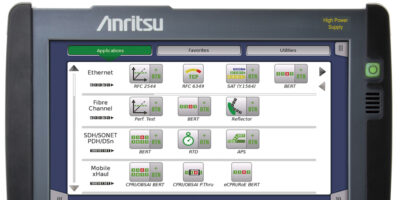Anritsu upgrades Network Master Pro MT1000A for 5G and O-RAN services
Claimed to be the smallest tester in its class to support mobile networks up to 100Gbits per second, the Network Master Pro MT1000A has been upgraded by Anritsu with a synchronous measurement function.
The MU100090B is a GNSS disciplined oscillator supporting GPS, Galileo, GLONASS, Beidou and QZSS. It receives signals from each of GNSS to output a UTC-traceable reference time signal as well as 10MHz signals as a time-synchronous, high-accuracy reference timing supplied to the portable MT1000A, supporting SyncE Wander and PTP tests up to 25Gbits per second for measuring network time synchronisation.
Anritsu hopes to facilitate construction of time-synchronous infrastructure, a key technology supporting 5G networks which are expected to support increasing levels of services such as hi-definition video streaming, autonomous driving, IoT sensing and smart factories.
Multiple MT1000A testers at remote sites can be operated and monitored from the central office using the site over remote access (SORA) MX109020A software to help quickly pinpoint synchronisation problems.
The company has added the high performance GNSS disciplined oscillator MU100090B to the range of modules for the portable, battery-operated MT1000A to help simplify on-site time-synchronisation tests.
The deployment of 5G communications networks brings advantages such as high speeds, high reliability, low latency, and multiple simultaneous connections. The millimetre wave (mmWave) band used by 5G technology employs the TDD time-division duplexing technology to manage the timing of uplink and downlink signals. This technology requires that the time at all base stations is precisely synchronised. Additionally, an IoT-based society will require co-operation between devices exchanging position information acquired using observed time difference of arrival (OTDOA) positioning technology, which requires high-accuracy time synchronisation between base stations.
Base stations can be synchronised using wired-network technologies called SyncE and PTP, which require both measurement of the network time-synchronisation performance when installing and maintaining a cell site, and a guaranteed network performance, explains Anritsu.
The O-RAN Alliance increasingly requires tests of overall mobile network time-synchronisation performance to assure interconnectivity.
Time-synchronisation quality is indicated by drift from co-ordinated universal time (UTC), so precise time-synchronisation measurement requires expensive infrastructure, adds Anritsu.




